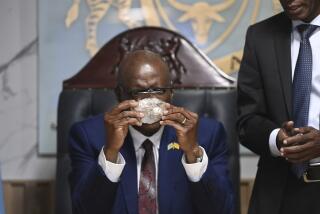Diamonds Bolster Botswana’s Economy
- Share via
JWANENG, Botswana — The sand sheets, short hills and wind-blown dunes of the Kalahari Desert seem to foreshadow unending economic desolation for the people of Botswana.
But amid that desolation, a monstrous gray-and-brown gash sinks like a scar through the desert floor--a man-made canyon jammed with diamonds that has helped transform Botswana from one of the world’s poorest countries to one of Africa’s most prosperous.
Roughly every third diamond on the $6-billion world market comes from this France-sized country of just 1.5 million people.
In many parts of Africa, diamonds fuel brutal conflicts. In Botswana, they have been nothing but a salvation since they were discovered 33 years ago. The economy has soared. Average salaries have risen from the depths of poverty to livable standards. The education and health care systems have become the envy of the developing world.
Revenue Supports Schools, Roads
“Every school and every road and every post office that you see in this country is paid for by diamond revenue,” said Louis Nchindo, the managing director of Debswana, the company that controls the diamond trade here. “Everything you see here in the way of development has been due to diamonds.”
While many African cities are caldrons of urban poverty, few beggars sit on the smooth streets of Gaborone, Botswana’s capital. Construction cranes line a horizon dotted with office parks and shopping centers. Parking lots are filled with shiny cars.
The ethnic fighting that has wounded much of Africa was never a problem in Botswana, whose people are all ethnic Tswanas. As repeated coups shook some neighboring countries and oppressive dictatorships stifled others, Botswana maintained a stable democracy--albeit one dominated by a single party.
Botswana is by no means trouble-free. Its HIV-infection rate is estimated to be the highest in the world. Unemployment is estimated to be at least 20%, and according to figures from 1993--the latest available--47% of the people live below the poverty line.
Still, the country is one of the brightest spots on the world’s poorest continent.
“Compared to the region that we’re in, we’re clearly doing very well,” said Keith Jefferis, deputy governor of the Bank of Botswana.
When Botswana gained its independence from Britain in 1966, the country was an economic basket case of deserts and sporadic cattle farms. The next year, diamonds were discovered at Orapa and Letlhakane and in 1972, prospectors found more at what would become the Jwaneng mine.
There is no glitter inside the mine. The oblong pit is 1 1/2 miles long, three-quarters of a mile wide and 750 feet deep. It looks more like a rock quarry than the largest producer of gem diamonds in the world. Huge yellow dump trucks ferry loads of gray boulders that are crushed to ever smaller sizes to allow diamonds to be shaken free.
Kaelekae Mosimane, who operates one of the crushing machines, has been working amid the swirling wind and groan of heavy machinery since 1981. The 50-year-old lives in a house in nearby Jwaneng, which belongs to the mine, and owns two other houses in his home village of Palapye, about 280 miles away.
Growing up on his father’s cattle farm in the 1950s, he was lucky to own two shirts, he said.
“I knew people who used to have no clothes at all. It was not that bad for us,” Mosimane said. “That was the time when things were still tough and the country was still poor. Not like now.”
Botswana’s government, which jointly owns Debswana with the international diamond giant De Beers, receives more than 75 percent of the profit from its resource, according to economic analysts.
In the past three decades, Botswana’s economy has grown at about 7% a year. Average annual household income has exploded from about $80 to $3,600. Its $6 billion in foreign reserves is so large that the government could stop collecting money for two years and still maintain current spending levels.
Diamonds account for 50% of government revenue, 75% of export earnings and 30% of gross domestic product, but they alone do not explain Botswana’s remarkable growth.
Fiscal Prudence Is a Big Factor
Analysts attribute much of Botswana’s success to its fiscal prudence. Officials are willing to listen to economic advice and are more committed to their country than their own pockets, said Charles Harvey, an analyst at the Botswana Institute for Development Policy Analysis.
“Nobody goes to Paris or Miami for their summer holiday. They go to their cattle posts . . . which is a far better way of spending your time than gambling your people’s money,” he said.
Not everyone has shared in Botswana’s prosperity.
Segametsi Phokompe, 23, lives in a small four-room house in Gaborone’s Old Naledi neighborhood with 22 relatives, only two of whom work. She and her four siblings all graduated from high school, but found no room in the country’s only university. Many employers looking for unskilled labor did not want to pay higher wages to high school graduates.
“There are no jobs. There is no way to find a job,” Phokompe said. “We are suffering.”
Analysts worry about the economy relying so heavily on diamond revenue, which will eventually dry up, and on government spending, which accounts for about 40% of gross domestic product.
Increased tourism and a growing financial services industry are helpful, but only the labor-intensive manufacturing sector holds any real hope of reducing the country’s unemployment problem, said Jefferis.
Still, Harvey sees a potentially bright future for a country with few strikes, low taxes and little business corruption. The government’s investment in education, roads and new office buildings should begin to attract the international investors Botswana will need to continue prospering.
“Fundamentally, they are doing the right things,” he said.
More to Read
Sign up for Essential California
The most important California stories and recommendations in your inbox every morning.
You may occasionally receive promotional content from the Los Angeles Times.












